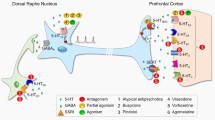Summary
An in vivo model for investigating the interaction of drugs with presynaptic receptors was used to study the effect of chronic treatment of rats with fluphenazine decanoate on the presynaptic dopamine receptors in the neostriatum and olfactory tubercle. In this model system dopaminergic impulse flow is inhibited pharmacologically with γ-butyrolactone (GBL). This results in an increase of apparent tyrosine hydroxylase activity, estimated by the accumulation of a dopa during the 30-min interval following administration of a dopa decarboxylase inhibitor. Dopamine agonists produce a dose-dependent blockade of the effect of GBL on dopa accumulation.
On days 12 through 21 after rats were injected with fluphenazine decanoate, 2 dopamine agonists-apomorphine (tested on days 12, 15, 17, and 21) and trivastal (ET 495; piribidel; tested on days 12, 14, and 19)-were more potent in blocking the GBL-induced increase of dopa accumulation in the striata of treated animals than in controls. Thirty days after the fluphenazine injection the effect of the dopamine agonists on dopa accumulation in the neostriatum returned to control levels. On Day 14 after fluphenazine decanoate injection the dose-response curve of apomorphine's inhibitory effect on the GBL-induced increase of dopa accumulation in the neostriatum was shifted to the left.
In control animals apomorphine was approximately 10-fold more potent in depressing the GBL-induced increase of dopa accumulation in the olfactory tubercles than in the neostriatum. Apomorphine was even more potent in the olfactory tubercle on day 14 after a single injection of fluphenazine decanoate. These results suggest that following chronic treatment of rats with a phenothiazine, presynaptic receptors on dopamine nerve terminals in the striatum and limbic system become supersensitive to dopamine agonists.
Similar content being viewed by others
References
Bieger, D., Larochelle, L., Hornykiewicz, O.: A model for the quantitative study of central dopaminergic and serotonergic activity. Eur. J. Pharmacol. 18, 128–136 (1972)
Bunney, B. S., Aghajanian, G. K., Roth, R. H.: l-DOPA, amphetamine and apomorphine: comparison of effects on firing rate of rat dopaminergic neurons. Nature New Biol. 245 123–125 (1973a)
Bunney, B. S., Walters, J. R., Roth, R. H., Aghajanian, G. K.: Dopaminergic neurons: Effect of antipsychotic drugs and amphetamine on single cell activity. J. Pharmacol. Exp. Ther. 185, 560–571 (1973)
Carlsson, A., Hehr, W., Lindqvist, M., Magnusson, T., Atack, C. V.: Regulation of monoamine metabolism in the central nervous system. Pharmacol. Rev. 24, 371–384 (1972)
Christiansen, J., Squires, R. F.: Antagonistic effects of apomorphine and haloperidol on rat striatal synaptosomal tyrosine hydroxylase. J. Pharm. Pharmacol. 26, 367–369 (1974)
Corrodi, H., Fuxe, K., Ungerstedt, U.: Evidence for a new type of dopamine receptor stimulating agent. J. Pharm. Pharmacol. 23, 981–991 (1971)
Fjalland, B., Møller, Nielsen, I.: Enhancement of methylphenidate-induced stereotypies by repeated administration of neuroleptics. Psychopharmacologia 34, 105–109 (1974)
Gianutsos, G., Hynes, M. D., Lal, H.: Enhancement of apomorphine-induced inhibition of striatal dopamine-turnover following chronic haloperidol. Biochem. Pharmacol. 24, 581–582 (1975)
Glowinski, J.: Effects of neuroleptics on the nigroneostriatal and mesocortical dopaminergic systems. In: Biology of the Major Psychoses, Res. Publ. Assoc. Res. Nerv. Ment. Dis. 54, 233–276 (1975)
Iversen, L. L., Rogawski, M. A., Miller, R. J.: Comparison of the effects of neuroleptic drugs on pre-and post-synaptic dopaminergic mechanisms in the rat striatum. Mol. Pharmacol. 12, 251–263 ( (1976)
Jackson, D. M., Anden, N.-E., Engel, J., Liljequist, S.: The effect of long-term penfluridol treatment on the sensitivity of the dopamine receptors in the nucleus accumbens and in the corpus striatum. Psychopharmacologia45, 151–155 (1975)
Kehr, W., Carlsson, A., Lindqvist, M.: A method for the determination of 3,4-dihydroxyphenylalanine (DOPA) in brain. Naunyn-Schmiedeberg's Arch. Pharmacol. 274, 273–280 (1972)
Klawans, H. L.: The pharmacology of tardive dyskinesias. Am. J. Psychiatry 130, 82–86 (1973)
Sayers, A. C., Burki, H. R., Ruch, W., Asper, H.: Neuroleptic-induced hypersensitivity of striatal dopamine receptors in the rat as a model of tardive dyskinesias. Effects of clozapine, haloperidol, loxapine, and chlorpromazine. Psychopharmacologia 41,97–104 (1975)
Scatton, B., Garrett, C., Julou, L.: Acute and subacute effects of neuroleptics on dopamine synthesis and release in the rat striatum. Naunyn-Schmiedeberg's Arch. Pharmacol. 289, 419–434 (1975)
Tarsy, D., Baldessarini, R. J.: Pharmacologically induced behavioural supersensitivity to apomorphine. Nature New Biol. 245, 262–263 (1973)
Ungerstedt, U.: Striatal dopamine release after amphetamine or nerve degeneration revealed by rotational behaviour. Acta Physiol. Scand. Suppl. 367, (1971)
Voigtlander, P. F. Von, Losey, E. G., Triezenberg, H. J.: Increased sensitivity to dopaminergic agents after chronic neuroleptic treatment. J. Pharmacol. Exp. Ther. 193, 88–94 (1975)
Walters, J. R., Roth, R. H.: Dopaminergic neurons: drug-induced antagonism of the increase in tyrosine hydroxylase activity produced by cessation of impulse flow. J. Pharmacol. Exp. Ther. 191, 82–91 (1974)
Walters, J. R., Roth, R. H.: Pre-and Postsynaptic Actions of Antipsychotic Drugs. In: Antipsychotic Drugs, Pharmacodynamics and Pharmacokinetics. Wenner-Gren Center International Symposium Series. New York: Pergamon Press 1975
Walters, J. R., Roth, R. H.: Dopaminergic neurons: an in vivo system for measuring drug interactions with presynaptic receptors. Naunyn-Schmiedeberg's Arch. Pharmacol. 296, 5–14 (1976)
Walters, J. R., Aghajanian, G. K., Roth, R. H.: Dopaminergic neurons: Inhibition of firing by γ-hydroxybutyrate. Proc. Fifth Cong. Pharmacol. p. 246 (1972)
Walters, J. R., Bunney, B. S., Roth, R. H.: Peribidel and apomorphine: Pre-and post-synaptic effects on dopamine synthesis and neuronal activity. In: Advances in Neurology, Vol. 9 (D. Calne, T. N. Chase, and A. Barbeau, ed.). New York:Raven Press 1975
Westfall, T. C., Besson, M.-J., Giorguieff, M.-F., Glowinski, J.: The role of presynaptic receptors in the release and synthesis of 3H-dopamine by slices of rat striatum. Naunyn-Schmiedeberg's Arch. Pharmacol. 292, 279–287 (1976)
Yarbrough, G. C.: Supersensitivity of caudate neurones after repeated administration of haloperidol. Eur. J. Pharmacol. 31, 367–369 (1975)
Author information
Authors and Affiliations
Rights and permissions
About this article
Cite this article
Nowycky, M.C., Roth, R.H. Presynaptic dopamine receptors. Naunyn-Schmiedeberg's Arch. Pharmacol. 300, 247–254 (1977). https://doi.org/10.1007/BF00500967
Received:
Accepted:
Issue Date:
DOI: https://doi.org/10.1007/BF00500967




